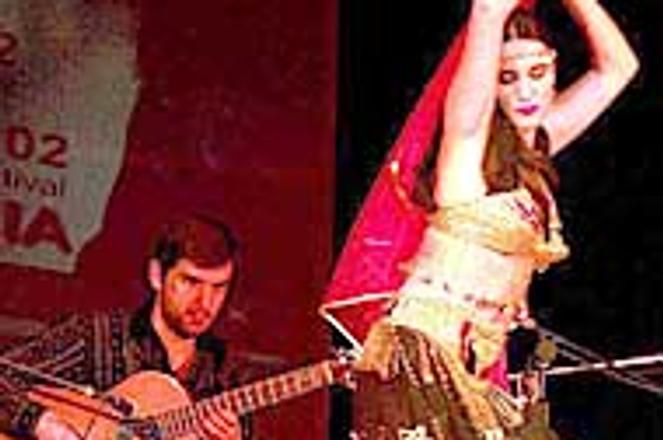POLISH Anny Mendak and her Danza del Fuego band.photo: Courtesy of Una Musica
A MIDDLE-EASTERN belly dance performed by Anny Mendak of Poland is part of this year's Bratislava Flamenco Festival. The underlying theme of this year's festival, the organisers say, is to show the parallels between Middle Eastern and flamenco musical styles, and to bring to the public's attention flamenco's roots in Indian traditional music.
"Flamenco is one big fusion of gypsy culture and Andalusian folklore. It is also influenced by Middle Eastern - Arabic and Jewish - culture," says flamenco specialist and music critic Pavol Šuška.
He explains that flamenco's roots are Indian and part of the Romany culture that originally came from there. Romany people left the subcontinent sometime in the seventh or eighth century and passed through Persia and Europe, finally arriving in Spain during the first half of the 15th century. It was then that flamenco first started to take shape as a dance form.
During the 20th century, flamenco spread across the world and underwent various changes. Now, while some groups try to create modern fusions, mixing flamenco with jazz, Latino and other styles, others try to preserve flamenco in its traditional, purest form.
SPANISH dancer Juan Polvillo.photo: Courtesy of Una Musica
"The ability to broaden itself by using other influences is flamenco's nature, as its base is founded on fusions," says Šuška.
The five-day flamenco festival will feature a handful of flamenco musicians and dancers from several countries performing in the traditional flamenco style as well as presenting their own modern interpretations of flamenco. There will be two performances each day and the festival will culminate in a gala concert on November 23.
Guitarist Martin Kellner, who is best known for playing with world-music singer Tina Brauner, will open the festival on November 19, performing with percussionist Christian Stanger from Austria. They will be followed by the Slovak world music ensemble Los Remedios, which fuses flamenco with jazz as well as modern classical music. On November 20 modern flamenco guitarist Petr Štěpánek from the Czech Republic will accompany dancer Hana Hercherová, and Slovak music-dance ensemble Los Flamenquitos will present traditional flamenco alongside their own arrangements.
On November 21 the world-famous flamenco dancer from Seville Juan Polvillo will perform with Slovak guitarist Morenito de Triana. Belly dancer Mendak will perform to traditional Indian music with the group Danza del Fuego on November 22.
"Even though flamenco originated in Spanish Andalusia, it's not Spanish or Andalusian art. It's only geographically tied to Spain, and since it has spread around the world, it's basically developing independently from Andalusia," says the flamenco specialist Šuška, who will give a lecture on flamenco history during the festival on November 20.
SLOVAK Matúš Kohútek performs with his group, Lagrima.photo: Ctibor Bachratý
According to Šuška and the festival's organizer, Matúš Kohútek from the non-profit group Una Musica, the fact that most of the groups performing at the festival are Slovak is not because the event is taking place in Slovakia, but because the country - and specifically Bratislava - has a richer flamenco scene than the surrounding countries.
Currently, there are seven music-dance flamenco groups in Slovakia, either performing traditional flamenco or modern fusions and often working with Spanish professionals. Such is the case with the Lagrima septet and one of its guitarists, Morenito de Triana (aka Stanislav Kohútek), who has been working with the flamenco dance master Juan Polvillo for more than three years.
"Slovakia is unique among the eastern and central European countries in that it has such a high number of flamenco musicians. There are no more than two such groups in any of those other countries," says the festival's organiser Kohútek, who plays piano in Los Remedios as well as Lagrima groups. He also states that the Bratislava Flamenco Festival is the only one of its kind in eastern and central Europe.


